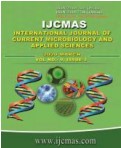


 National Academy of Agricultural Sciences (NAAS)
National Academy of Agricultural Sciences (NAAS)

|
PRINT ISSN : 2319-7692
Online ISSN : 2319-7706 Issues : 12 per year Publisher : Excellent Publishers Email : editorijcmas@gmail.com / submit@ijcmas.com Editor-in-chief: Dr.M.Prakash Index Copernicus ICV 2018: 95.39 NAAS RATING 2020: 5.38 |
The study was carried out during 2018-19 to evaluate energy efficiency and economical benefits of pigeonpea [Cajanus cajan (L.) Millsp.] – neem (Azadirachta indica A. Juss.) based agroforestry system in under rainfed condition North-eastern part of Karnataka, India. Among the directions, the energy use efficiency was non-significant. However, significantly lower EUE recorded with closer to tree line (2.20) and was increased as one moved away from the tree line and this was highest far away (3.31) from tree line. The gross returns were the maximum (₹ 55583/- ha-1 year-1) with pigeonpea on southern side at a distance of 10.8 to 16.2 m other directions at similar distances were comparable, while those planted near the tree line at < 5.4 m on the western side recorded the lowest gross returns (₹ 31029/- ha-1). Similar were the trends in net returns and B: C. The net returns and B: C were the maximum (₹ 40166/- ha-1 and 3.88, respectively) on southern side at 10.8 to 16.2 m, while those planted near the tree line at < 5.4 m on the western side of the tree line recorded the lowest net returns and B: C (₹ 15612/- ha-1 and 2.33, respectively). Sole crop of pigeonpea had gross and net returns and B: C of ₹ 45259 and 29842/- ha-1 and 2.97 respectively. Interestingly the agroforestry system of pigeonpea + neem with pigeonpea at > 10.8 m irrespective of direction of planting recorded higher returns and B: C than sole pigeonpea. In all, the economics followed crop yield and economic returns obtained from the tree component. Crop at > 10.8 m distance from neem have maximum EUE and economically profitable than sole crop.
 |
 |
 |
 |
 |